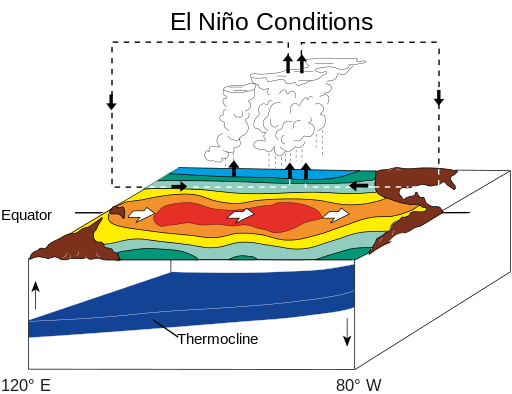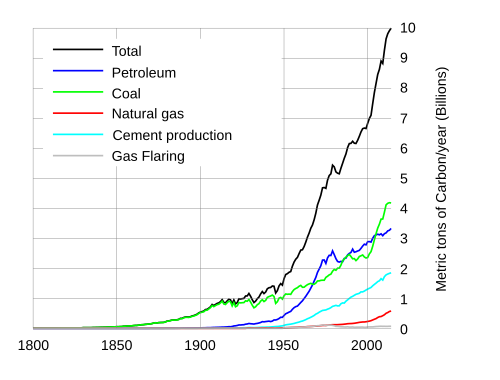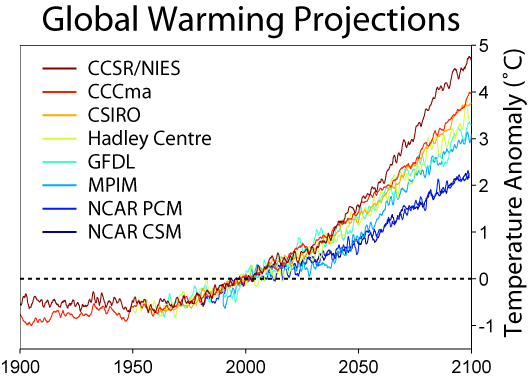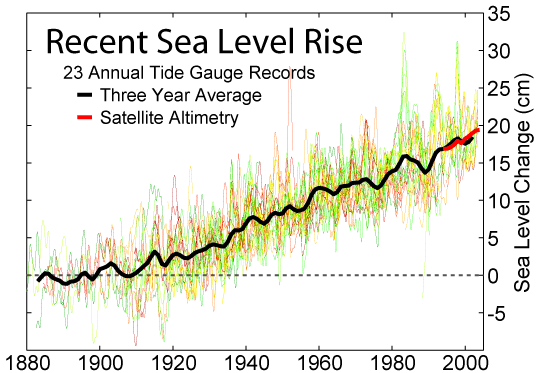High School Earth Science/Climate Change
For the past two centuries, climate has been relatively stable. People placed their farms and cities in locations that were in a favorable climate without thinking that the climate could change. But climate has changed throughout Earth history, and a stable climate is not the norm. In recent years, Earth's climate has begun to change again. Most of this change is warming due to human activities that release greenhouse gases into the atmosphere. The effects of warming are already being seen and will become more extreme as temperature rise.
Lesson Objectives
[edit | edit source]- Describe some ways that climate change has been an important part of Earth's history.
- Discuss what factors can cause climate to change and which of these can be exacerbated by human activities.
- Discuss the consequences of rising greenhouse gas levels in the atmosphere, the impacts that are already being measured, and the impacts that are likely to occur in the future.
Climate Change in Earth's History
[edit | edit source]
Climate has changed throughout Earth's history. At times, the Earth's climate was hotter and more humid than it is today, but climate has also been colder than it is today, when glaciers covered much more of the planet. The most recent ice ages were in the Pleistocene Epoch, between 1.8 million and 10,000 years ago (Figure 17.27). Glaciers advanced and retreated in cycles, known as glacial and interglacial periods. With so much of the world's water bound into the ice, sea level was about 125 meters (395 feet) lower than it is today. We are currently in a warm, interglacial period that has lasted about 10,000 years.
It is likely that the average global temperature during glacial periods was only 5.5°C (10°F) less than Earth's current average temperature. Temperatures during the interglacial periods were about 1.1°C (2.0°F) higher than today (Figure 17.28). Notice that fairly small temperature changes can have major effects on global climate. Over the last 900,000 years, Earth's average temperature has varied less than 5°C. Some scientists think that glaciers will advance again, but not for thousands of years.

Since the end of the Pleistocene, the global average temperature has risen about 4°C (7°F). Glaciers are retreating and sea level is rising. The climate has been relatively mild and stable when compared with much of Earth's history. Climate stability has been beneficial for human civilization. Stability has allowed the expansion of agriculture and the development of towns and cities. While climate is getting steadily warmer, there have been a few more extreme warm and cool times in the last 10,000 years. The Medieval Warm Period from 900 to 1300 A.D. allowed Vikings to colonize Greenland and Great Britain to grow wine grapes. When the climate cooled in The Little Ice Age, from the 14th to 19th centuries, the Vikings were forced out of Greenland and humans had to plant crops further south.
Short-Term Climate Oscillations
[edit | edit source]Short-term changes in climate are common as conditions oscillate (or change) from one state to another (Figure 17.29). The largest and most important of these is the Southern Oscillation between El Niño and La Niña conditions. This oscillation drives changes in climate that are felt around the world about every two to seven years.

In a normal year, the trade winds blow across the Pacific Ocean near the equator from east to west (in the direction of Southeast Asia), piling up warm water in the western Pacific Ocean and actually raising sea levels there by half a meter. Meanwhile, along the western coast of South America, the Peru Current carries cold water northward, and cold, nutrient-rich waters upwell from the deep sea. When the Peru Current nears the equator, it flows westward across the Pacific Ocean with the trade winds.
When water temperature reaches around 28°C (82°F), the trade winds weaken or reverse direction and blow east (towards South America). An El Niño cycle has begun (Figure 17.30). Warm water is dragged back across the Pacific Ocean, heating the central Pacific Ocean and the surface waters off the west coast of South America. With warm, low density water at the surface, no upwelling occurs along the coast of South America. Without upwelling, nutrients are scarce and plankton populations decline. Since plankton form the base of the food web, fish cannot find food, and fish numbers decrease as well. All the animals that eat fish, including birds and humans are affected by the decline in fish.

El Niño events change global climate when circulation patterns in the atmosphere and oceans change. Some regions receive more than average rainfall, including the west coast of North and South America; the southern United States; and Western Europe. Drought occurs in other parts of South America, the western Pacific, southern and northern Africa, and southern Europe.
An El Niño cycle lasts one to two years and ends when the warm mass of central Pacific water has moved eastward once more. Normal circulation patterns resume, but sometimes they are quicker and more energetic. This pattern, with unusually cold water in the eastern Pacific Ocean, is called La Niña (Figure 17.31). El Niño events take place every three to seven years but vary in their strength.

Other important oscillations are smaller and have a local, rather than global, effect. The North Atlantic Oscillation mostly alters climate in Europe. The Mediterranean also goes through cycles, varying between being dry at some times, and warm and wet at others.
Causes of Climate Change
[edit | edit source]Many natural processes cause climate to change. There can be changes in the amount of energy the Sun produces. As Earth orbits the Sun, there are also changes over thousands of years in the tilt of Earth's axis and orbit. Over millions of years, the positions of our continents change, driven by plate tectonic motions. Random catastrophic events, like a large asteroid impact can cause sudden, dramatic changes in climate. Human activities have greatly increased the amount of greenhouse gases in the atmosphere, which impacts global climate by warming the Earth.
Solar Vibration
[edit | edit source]The amount of energy the Sun radiates is variable. Sunspots are magnetic storms on the Sun's surface that increase and decrease over an 11-year cycle (Figure 17.32). When the number of sunspots is high, solar radiation is also relatively high. But the entire variation in solar radiation is tiny relative to the total amount of solar radiation that there is and there is no known 11-year cycle in climate variability. The Little Ice Age corresponded to a time when there were no sunspots on the Sun.
Plate Tectonics
[edit | edit source]Plate tectonic movements can alter climate. Over millions of years as seas open and close, ocean currents may distribute heat differently. For example, when all the continents are joined into one supercontinent (like Pangea), nearly all locations experience a continental climate. When the continents separate, heat is more evenly distributed. Plate tectonic movements may help start an ice age. When continents are located near the poles, ice can accumulate, which may increase albedo and lower global temperature. Low enough temperatures may start a global ice age.
Plate tectonics also triggers volcanic eruptions, which release dust and CO2 into the atmosphere. Ordinary eruptions, even large ones, have only a short-term effect on weather. Ash from the 1991 eruption of Mount Pinatubo in the Philippines cooled global temperature by around 0.5°C (0.9°F) for a year. Massive eruptions of a fluid type of lava can flood the surface, releasing much more gas and dust, changing climate for many years. This type of eruption is exceedingly rare; none has occurred since humans have lived on Earth.
Asteroid Impacts
[edit | edit source]If a large asteroid hits the Earth, it may trigger a mass extinction. This likely happened at the end of the Cretaceous period, around 65 million years ago. An asteroid 10 kilometers (6 miles) in diameter struck the Yucatan Peninsula in southeastern Mexico. About 85% of all species present on Earth at that time became extinct, including the dinosaurs. Dust that was kicked high into the atmosphere came together as rocks and fell to the ground. The organisms that survived had to endure extreme cold, as dust blocked the Sun for many years. Photosynthesis slowed down and the planet cooled to levels that were intolerable for many species.
Milankovitch Cycles
[edit | edit source]The most extreme climate of recent Earth history was the Pleistocene. Scientists attribute a series of ice ages to variation in the Earth's position relative to the Sun, known as Milankovitch cycles.
The Earth goes through regular variations in its position relative to the Sun:
- The shape of the Earth's orbit changes slightly as it goes around the Sun. Our orbit varies from more circular to more elliptical in a cycle lasting between 90,000 and 100,000 years. When the orbit is more elliptical, there is a greater difference in solar radiation between winter and summer.
- The planet wobbles on its axis of rotation. At one extreme of this 27,000 year cycle, the Northern Hemisphere points toward the Sun, when the Earth is closest to the Sun. Summers are much warmer and winters are much colder than now. At the opposite extreme, the Northern Hemisphere points toward the Sun when it is farthest from the
Sun. This results in chilly summers and warmer winters.
- The planet's tilt on its axis varies between 22.1° and 24.5°. Seasons are caused by the tilt of Earth's axis of rotation, which is at a 23.5° angle now. When the tilt angle is smaller, summers and winters differ less in temperature. This cycle lasts 41,000 years.
When these three variations are charted out, a climate pattern of about 100,000 years emerges. Ice ages correspond closely with Milankovitch cycles. Since glaciers can only form over land, ice ages only occur when landmasses cover the polar regions. Therefore, Milankovitch cycles are also connected to plate tectonics.
Rising Atmospheric Greenhouse Gases
[edit | edit source]Greenhouse gases in the atmosphere trap the heat that radiates off the planet's surfaces. Therefore, a decrease in greenhouse gas levels lowers the average air temperature. An increase in greenhouse gases raises air temperature. Greenhouse gas levels have varied throughout Earth history. For example, CO2 been present in Earth's atmosphere at concentrations less than 200 parts per million (ppm) and more than 5,000 ppm. But for 650,000 years or more, CO2 has never risen above 300 ppm, during either glacial or interglacial periods. CO2 levels are higher during interglacial than glacial periods (Figure 17.33).

Greenhouse gases are added to the atmosphere by natural processes, like volcanic eruptions, and the decay or burning of organic matter. Greenhouse gases are also removed from the atmosphere when CO2 is absorbed by plant tissue. When plants die and are turned into fossil fuels - coal, oil, natural gas - deep in the Earth, the CO2 they hold is stored with them. Storing CO2 in the ground removes the greenhouse gas from the atmosphere, lowering Earth's average temperature.
Human activities are now releasing much of this stored CO2 into the atmosphere. Although people have been burning wood and coal to meet their energy needs for hundreds of thousands of years, fossil fuel usage has increased dramatically in the past 200 years, since the Industrial Revolution. Fossil fuel use has skyrocketed in the past few decades as population has grown, and there are more and more cars, homes, and industries to power. Burning rainforests, to clear land for agriculture prevents the growing trees from removing CO2 from the atmosphere and releases all the CO2 stored in rainforest trees. With more people to feed, the destruction of rain forests has increased.
CO2 is the most important greenhouse gas that human activities affect. And, after water vapor, CO2 is the most abundant. But other greenhouse gases are increasing as well. Methane is released from raising livestock, rice production, and the incomplete burning of rainforest plants. Chlorofluorocarbons (CFCs) are human-made chemicals that were invented and used widely in the 20th century. Tropospheric ozone, mostly from vehicle exhaust, has more than doubled since 1976. All of these gases act as greenhouse gases as well as CO2.
Global Warming
[edit | edit source]With more greenhouse gases trapping heat, average annual global temperatures are rising. This is known as global warming. There is now nearly 40% more CO2 in the atmosphere than there was 200 years ago, before the Industrial Revolution. About 65% of that increase has occurred since the first CO2 measurements were made on Mauna Loa Volcano, Hawaii in 1958 (Figure 17.34).

The United States has been the largest emitter of greenhouse gases, with about 20% of total emissions in 2004 (Figure 17.35). China has been the second highest emitter (18.4%), followed by the European Union (11.4%). As a result of China's rapid economic growth, in early 2008 its CO2 emissions probably surpassed those of the United States. However, it's also important to keep in mind that the US has only about 1/5 the population of China. Therefore, the average US citizen produces far more greenhouse gases than the average Chinese person. If nothing is done to decrease the rate of CO2 emissions, by 2030, CO2 emissions are projected to be 63% greater than they were in 2002.

How much CO2 levels will rise in the next decades is unknown. It depends on how much CO2 emissions in developing nations increase. It also depends on how much technological advances or lifestyle changes increase or decrease emissions in developed nations. If nothing is done to control greenhouse gas emissions and they continue to increase at current rates, the surface temperature of the Earth can be expected to increase between 0.5°C and 2.0°C (0.9°F and 3.6°F) by 2050 and between 2° and 4.5°C (3.5° and 8°F) by 2100, with CO2 levels over 800 parts per million (ppm)(Figure 17.36). On the other hand, if severe limits on CO2 emissions begin soon, temperatures could rise less than 1.1°C (2°F) by 2100. Whatever the temperature increase, it will not be uniform around the globe. A rise of 2.8°C (5°F) would result in 0.6° to 1.2°C (1° to 2°F) at the equator, but up to 6.7°C (12°F) at the poles. So far, global warming has affected the North Pole more than the South Pole.

Changes in the Earth and organisms as a result of global warming are already being observed. While temperatures have risen since the end of the Pleistocene, 10,000 years ago, this rate of increase had been more rapid in the past century, and has even risen even faster since 1990. The eight warmest years on record have all occurred since 1998, and the 14 warmest years have occurred since 1990 (through 2007) (Figure 17.37).

As a result of these high temperatures, glaciers are melting and ice caps are breaking apart at the edges (Figure 17.38). Permafrost is melting, causing swamps in locations that were once frozen solid. Melting ice caps add water to the oceans, so sea level is rising (Figure 17.39). Also contributing to sea level rise is that water slightly expands as it warms—this expansion of water accounts for about one-quarter to one-half of the observed sea level change. Since warmer air can hold more moisture, storms are becoming more intense. Weather is therefore likely to be more severe with more heat waves and droughts. More rainfall sometimes results in increased flooding.


Plants and animals are feeling the effects of the changing climate. Winters are shorter so some animals are changing their seasonal behaviors: migrating earlier in the spring, for example. Coral reefs are dying worldwide due in part to the increase in surface ocean temperatures. Forests are also dying in some places because warm weather has allowed insect pests to expand their ranges into areas that were once too cold. As surface seas warm, phytoplankton productivity has decreased. Some regions that were already marginal for agriculture are no longer farmable, because they have become too warm or dry.
As greenhouse gases increase, changes will be more extreme. Oceans will become slightly more acidic, making it more difficult for creatures with carbonate shells to grow, including coral reefs. A studying monitoring ocean acidity in the Pacific Northwest found ocean acidity increasing ten times faster than expected and 10 to 20 percent of shellfish (mussels) replaced by acid tolerant algae.
Plant and animal species seeking cooler temperatures will need to move poleward 100 to 150 km (60 to 90 miles) or upward 150 m (500 feet) for each 1.0°C (8°F) rise in global temperature. There will be a tremendous loss of biodiversity because forest species can't migrate that rapidly. Even if they could, human development would block their spread and stop them from colonizing many new areas. Parks and wildlife refuges might be left protecting nothing. And biologists have already documented the extinction of high altitude species that have nowhere higher to go.
Decreased snowpacks, shrinking glaciers, and the earlier arrival of spring will all lessen the amount of water available in some regions of the world, including the western United States and much of Asia. Ice will continue to melt and sea level is predicted to rise 18 to 97 cm (7 to 38 inches) by 2100 (Figure 17.40). An increase this large will gradually flood coastal regions where about one-third of the world's population lives, forcing billions of people to move inland.

There will be more severe heat waves and heat-related illnesses and deaths. Drought could make many marginal regions uninhabitable. Some modelers predict that the Midwestern United States will become too dry to support agriculture and the areas that currently produce our best agriculture would move into Canada. In all, about 10 to 50% of current cropland worldwide may become unusable if CO2 doubles.
Although scientists do not all agree, hurricanes are likely to become more severe and possibly more frequent. Hurricanes cause a tremendous loss of life in developing nations and a loss of property in developed ones. Tropical and subtropical insects will expand their ranges. This will result in the spread of tropical diseases such as malaria, encephalitis, yellow fever, and dengue fever.
You may notice that the numerical predictions above contain wide ranges. Sea level, for example is expected to rise somewhere between 18 and 97 cm—quite a wide range. This uncertainty is partly because scientists cannot predict exactly how the Earth will respond to increased levels of greenhouses gases. How quickly greenhouse gases continue to build up in the atmosphere depends in part on the choices we make.
Lesson Summary
[edit | edit source]- Climate has changed throughout Earth's history. In general, when greenhouse gas levels are high, temperature is high.
- Greenhouse gases are now increasing due to human activities, especially fossil fuel use.
- We are already seeing the effects of these rising greenhouse gases in higher temperatures and changes to physical and biological systems.
- Society must choose to reduce greenhouse gas emissions or face more serious consequences.
Review Questions
[edit | edit source]- Why is the climate currently warming?
- Why does sea level rise and fall during interglacial and glacial periods?
- How can the human history of Greenland be related to climate cycles?
- Why did human civilization not develop significantly until the Pleistocene ended?
- If climate has been much warmer in Earth history, why do we need to worry about global warming now?
- When the weather along coastal California is especially rainy with many winter storms, what is likely to be happening in the equatorial Pacific in terms of the Southern Oscillation?
- The Peruvian anchovy fishery collapsed in 1972. Using what you know about climate and food webs, can you devise an explanation for this event?
- What two events must occur for there to be an ice age?
- What human activities are responsible for increasing greenhouse gases in the atmosphere?
- Why are CO2 emissions projected to increase by so much during the next few decades?
- What role do the developed nations play a role in increasing CO2 emissions in the next few decades?
- Why do storms increase in frequency and intensity as global temperatures increase?
- Earth is undergoing some important changes, some of which are known about and monitored by satellites. Describe the sort of global change that satellites can monitor.
- What will happen if sea level rises by 60 cm (2 feet) by the end of this century? Which locations will be hardest hit?
- What can be done to reduce greenhouse gas emissions?
Vocabulary
[edit | edit source]- asteroid
- A chunk of rock or ice that moves through the solar system.
- El Niño
- Part of the Southern Oscillation in which the trade winds weaken or reverse directions, and warm water accumulates on the ocean surface off of South America.
- global warming
- The global increase in average global temperature that has been taking place due to human activities.
- La Niña
- Part of the Southern Oscillation in which the trade winds are stronger than normal and surface water off of South America is cold.
- mass extinction
- An extinction in which 25% or more of the planet's species die out in a fairly short period of time.
- Milankovith cycles
- Cycles in Earth's position relative to the sun that affect global climate, resulting in a cycle of around 100,000 years.
- Southern Oscillation
- A reversal of normal atmospheric low and high pressure conditions in the Pacific Ocean.
- sunspot
- Sunspots are magnetic solar storms on the Sun that cause solar radiation to decrease slightly. Sunspots come and go over an 11-year cycle.
Points to Consider
[edit | edit source]- Nearly all climate scientists agree that human activities are causing the accelerated warming of the planet that we see today. Why do you suppose that the media is
still talking about the controversy in this idea when scientists are almost entirely in agreement?
- If greenhouse gas emissions must be lowered to avoid some of the more serious consequences of global warming, why have humans not done something to lower these
emissions instead of letting them increase?
- In what ways can progress be made in reducing greenhouse gas emissions? Think about this on a variety of scales: for individuals, local communities, nations, and the global community.